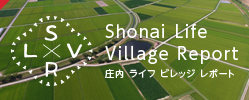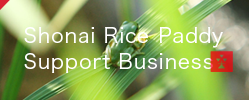Ishinomaki Rice Paddy Support Business May.2018. From Shonai to Ishinomaki JP EN
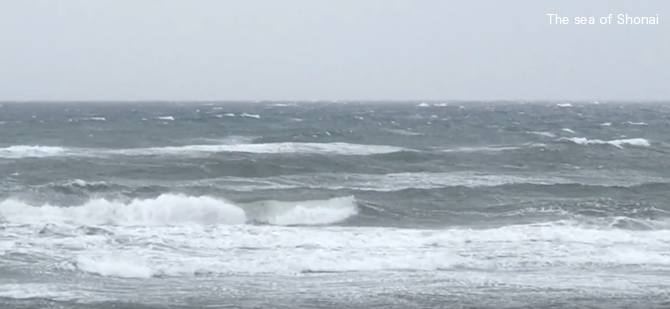
The first initiative of our “Rice Paddy Support Business” was to support business for a rice farmer in the city of Tsuruoka, Yamagata Prefecture. In November, when the 2017 harvest was complete, our role had finished. The supported farmer had established a financial base and is in the process of continuing to produce highly valued rice. I believed that it was a situation in which we could make a modest contribution.
This project has been going on for three years now and has been covered in our “Shonai Rice Paddy Support Business” episodes covering our various visits to Shonai during the project.
“Shonai Life Village Report”is a project in which we tried to describe the nature and life faithfully in the Shonai region where this rice farmer is located. Centering on the circulation of water, the report follows the flow of water from its origin in the virgin forest of beech trees, located at the foot of Mt. Gassan. It reaches and is then distributed around the village's arable land, allowing for the raising of fireflies at the water’s edge where the children play, supporting life and those living in the springwater town, and returning to the sea where the fishing of Japanese mackerel thrives. Once the winter snow storms have ended, spring in the Shonai region is welcomed in with the newly brewed sake festival and the rice planting season, coinciding with the start of the Sakura Masu (Cherry Salmon) season. The story of water and its cycle then conclude. The next theme becomes about soil. Thus, we started reporting about it using traditional farming methods, growing local varieties, producing experiment soils with humified organic matter, and the circulation of those valuable resources.
For the second project of our “Rice Paddy Support Business,” in response to a request from a rice farmer in the city of Ishinomaki, Miyagi Prefecture, we decided to undertake a new challenge. This time also, I’d like to share with you a variety of episodes that will come out during the course of the project.
Geographical relationship between Ishinomaki and Tsuruoka
The city of Tsuruoka on the Japan Sea, and the city of Ishinomaki on the Pacific side of the island of Honshu are at about the same latitude; a distance of 135km as the crow flies. By car, the route can be drawn as a gradual arc, which goes south and eastward from the city of Tsuruoka as it passes the south side of Mt. Gassan, crosses the Yamagata Basin, goes between Mt. Funagatayama and Mt. Zao, and then heads up north. The mileage amounts to a little over 200km.
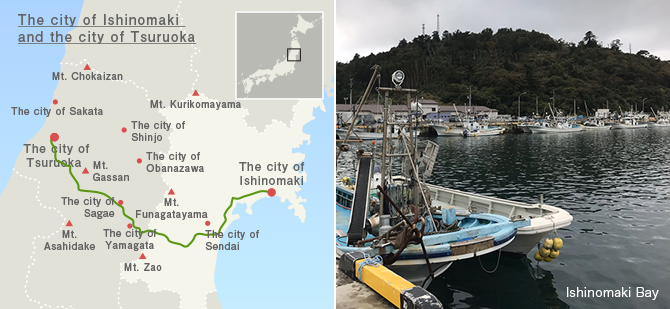
The relationship with Ishinomaki
In late October 2017, I visited Ishinomaki again after a long time.
Prior to this visit, the first time I had come to Ishinomaki was a few months after the great earthquake. I arrived on June 4, 2011. Having established a connection with a host, I went there as a volunteer of an organization which was going for reconstruction assistance.
Just a little more than two months after the tsunami hit the town and left it behind, it looked rather void of color, and there was the rancid odor of fish rising through the air. It was a visit that I felt conscience-stricken and could barely move. I wasn’t able to do anything. Looking at Ishinomaki Bay six years later, I am stunned and dismayed again by the fact that I can’t get beyond the same feeling as 6 years before.
In late October 2017, I visited for the first time in a while a paddy in Ishinomaki again. It had already been harvested, and new rice plants had regenerated from the stubble. A rice farmer informed me that it is called “Hikobae” (sprouts from a stump or stubble).
And a seri (Japanese parsley) farmer, who lives in Natori, Miyagi Prefecture and whose contributions to the area are broad, while continuing to make extraordinary efforts in farming,
taught me that these sprouts will become valuable part of the diet of migratory birds flying through in the winter. The farmer also said the paddy ecosystem seems similar to a mandala, not a pyramid structure. It is important to have a mandala as the model. I, who am frustrated with the harmful effects going against one’s own conscience and instead obsessing with over-organization and over-management, am deeply interested in this idea.
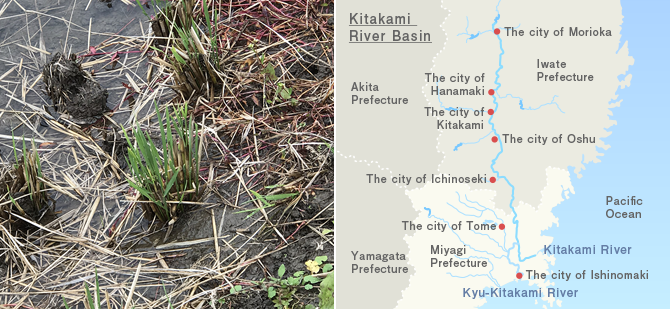
In the Shonai reports, we have focused on the circulation of water. As well, for the Rice Paddy Support Business of Ishinomaki, we will also pay attention to the journey of soil. We would like to touch on the origin and the nature of the soil in the Kitakami River basin.
Kitakami River is the largest river in the Tohoku region, with a catchment area of 10,150 sq kilometers, and a length of 249 kilometers for the trunk river. This river runs longitudinally through Iwate and Miyagi prefectures, and divides into Kitakami River and Kyu-Kitakami River downstream around Tome, Miyagi Prefecture. The area about 15 kilometers from the estuary of Kyu-Kitakami River will be the focus of our next report.
This place is the origin of the Sasanishiki rice, which has become a rare kind now. Sasanishiki was once the top brand of rice, dividing its popularity with Koshihikari rice. But in 1993, a year recording record cool summer temperatures, you may remember this year for bringing about the “Rice Riot of Heisei”. Emergency imports of Thailand rice was needed, and the harvest of Sasanishiki, which is weak in cold weather, rapidly decreased. There is data showing that the planting area for Koshihikari rice was 37.6%, and only 0.5% for Sasanishiki rice. ([Top 20 crops by ratio of paddy field to non-glutinous rice varieties], 2010.)
Source: [The Basics of Rice to Understand from Scratch] (Supervised by Kiyoaki Maruyama, Seibundo Shinkosha Co., Ltd. P85).
Sasanishiki is now a rare kind, but there are still chefs and consumers who are attracted by its refined taste that matches well with various Japanese dishes, including sushi. Encouraged by this demand, Miyagi Prefecture, the birthplace of Sasanishiki, has a farmer in the city of Ishinomaki that oversees and cultivates this rice. This farmer has adopted natural farming methods, which use neither fertilizers nor herbicides. This farmer will have a facility, which can be shared with neighboring farmers, and plans to plant Sasanishiki in the area. In response to this farmer's request, we agreed with the plan and started supporting them since 2017.
In the course of supporting this farmer in Ishinomaki, we will share several episodes as “Rice Paddy Support of Ishinomaki” with you.




